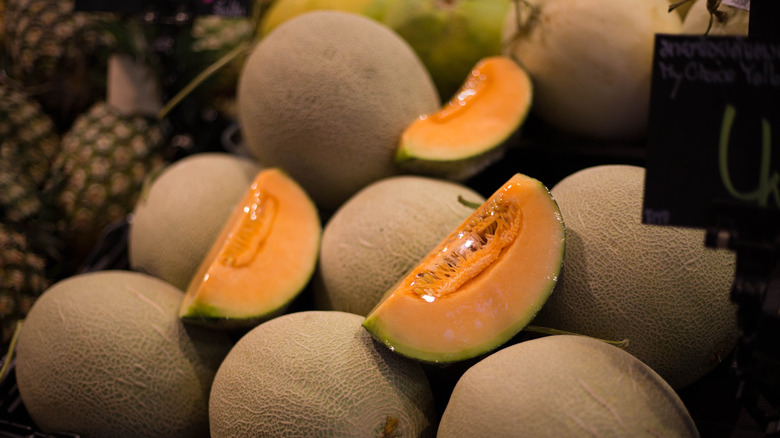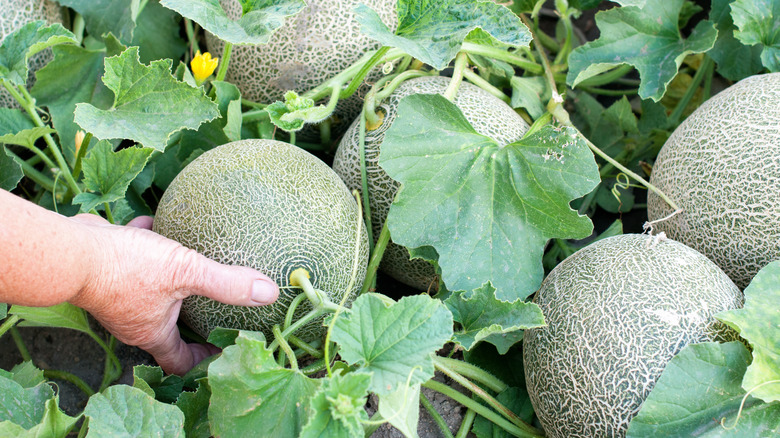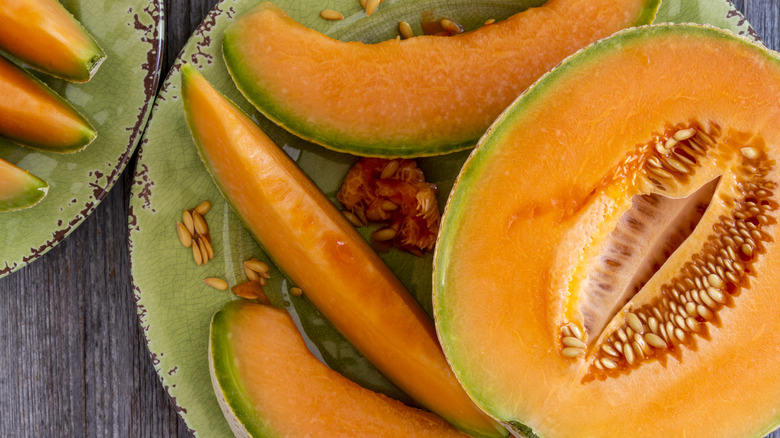What You Need To Know About California's New Cantaloupe Buying Tips
When thinking about cool, refreshing summertime melons, most of us likely think of watermelon, that ruby-red, classic cookout treat. But melon season, which typically runs from May to September, according to Day to Day Eats, also brings sweet, light green honeydew and pale orange, fragrant cantaloupe to grocery stores and farmers markets — and these fruits can be just as welcome at any barbecue as watermelon.
Far beyond basic slices or melon balls, ripe cantaloupe can hold its own in any number of dishes, from chef Alex Guarnashelli's cool cantaloupe soup served with diced cucumber to cold popsicles made from the roasted fruit that's then blended with condensed milk. But although cantaloupe has the potential to be musky and sweet, it seems like all too often, the ones we grab at the store can turn out surprisingly tasteless once we cut into them. That's because selecting the best melon is not always easy.
Though tricks such as checking to make sure no stem is left on the cantaloupe being sold — as the attached stem will impede its ripening process (via Delishably) — these shopping tips don't always result in selecting a delicious cantaloupe. And, as it turns out, you might not need those tips anymore anyway, as cantaloupe growers are now recommending a whole new set of guidelines for selecting a great melon at the store.
New cantaloupe varieties have a longer shelf life
In the past, many of us have relied on standard cantaloupe-selecting advice — such as seeking a cream, not green, color, and sniffing it to check for a sweet smell — when trying to find a ripe melon at the store or greenmarket (via Delishably). But according to California cantaloupe growers, many of those guidelines are now outdated, as farmers have developed new, longer-lasting cantaloupes that can be checked for ripeness in different ways.
In a press release, the California Cantaloupe Advisory Board, which represents growers of the fruit in that state, let the melon-buying public know that globally, a majority of cantaloupe farmers are planting newer varieties that have a longer shelf life. These melons, which the press release notes have been developed with traditional cross-pollination methods and which are not genetically modified, are being selected in order to help reduce food waste, as they last longer both in supermarkets and in your fridge.
"Plant breeders are constantly working to improve cantaloupe varieties to give you the best eating experience possible," Garrett Patricio of the California melon supplier Westside Produce wrote in the release. "These new varieties are bred to be sweeter and to have firmer flesh, which means they last longer on store shelves and in people's refrigerators. This means they can help people stretch their food dollars and less food ends up in the trash."
These new varieties call for different methods for choosing one at the store
According to the California Cantaloupe Advisory Board, new cantaloupes have different traits, so picking out a good one at the store is now a different process. Shoppers were once advised to look for a white or cream-colored "netting" (the raised pattern on the outside of the fruit), as a green-hued fruit wouldn't ripen any further (via OOLA). Now, the advisory board indicates, green cantaloupes are fine.
Shoppers have also been told to make sure no stem is left attached to the melon, as previous varieties did not ripen once they were cut from the vine. Now, according to the press release, melons with stems or without are good choices, as long as the netting on the fruit goes all the way up to the stem's end.
Perhaps the most reliable way many of us have found a ripe cantaloupe in the past is by checking it for a fragrant smell (via Delishably). But newer varieties, the press release indicates, don't emit the natural gas responsible for that smell — which is part of the reason why the melons last longer — but the fruit is still just as sweet, or sweeter, than older varieties.
Previously, California melons had to test for 12 brix, a level of sweetness, in order to go to market, while newer melons clock in at 14 or 15 brix. "You can expect a very sweet eating experience," Garrett Patricio of Westside Produce told the advisory board.


